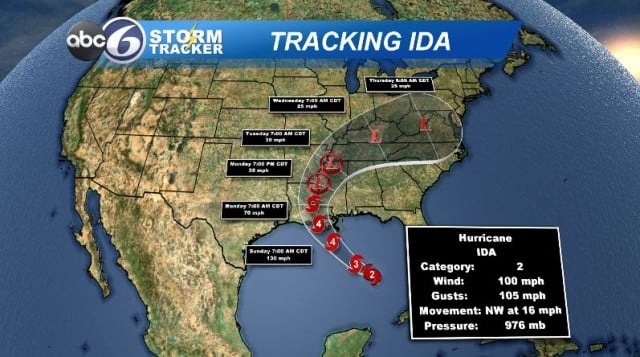

This outcome lies between the eastern and western clusters of modeling, and is the NHC official forecast as of mid-day Sunday, with a possible timing of landfall late Thursday or Friday.

Scenario 3: Tampa Bay area to Apalachee Bay (40% chance) Note that major wind, wave, rain, and surge impacts are probable in this zone even without Ian making landfall near or south of Tampa. The eastern model shift trend continued Sunday evening, and the GFS model, which was a western outlier, now has Ian stalling out 50 miles west of Tampa before turning back north toward Apalachee Bay. The last Category 3+ hurricane to directly strike the Tampa Bay region was in 1921, but that outcome is on the table and may even be edging closer. The faster Ian comes ashore, the less time it will have to weaken from its peak intensity. Probable timing of landfall in this region would be Wednesday or early Thursday. In addition to support from some models, delayed intensification and a trend towards slightly stronger troughing make this scenario physically plausible. This region is in the eastern portion of the NHC cone of uncertainty, and a landfall in the Tampa Bay metro area or as far south as the Fort Myers vicinity is a major possibility. Scenario 2: Southwest Florida to Tampa Bay area (40% chance) Rainfall and outer bands of Ian will move across the Keys and South Florida metro areas on Tuesday and Wednesday. Ian has already moved too far west for a track through Southeast Florida. Let’s see how those observations and model trends add up for four Florida impact scenarios: Scenario 1: Keys and Southeast Florida (Minimal chance) Recent GFS runs have also been trending stronger with this trough, hinting that Ian’s forecast may nudge a little bit back east over the next day. trough out-to-sea too quickly, given its bias to underestimate the strength of ridges in the western Atlantic. Overall, the GFS is probably booting the eastern U.S. A stronger trough would steer Ian into making a sharper and faster turn northeast and back towards Florida on Wednesday and Thursday. The European and UKMET models and their ensembles targeting west central Florida have that dip in the jet stream extending a little further south and hanging around the East Coast longer than the American GFS model, which brings Ian into the eastern Panhandle. The other major disagreement is in the precise strength of the eastern U.S.


 0 kommentar(er)
0 kommentar(er)
